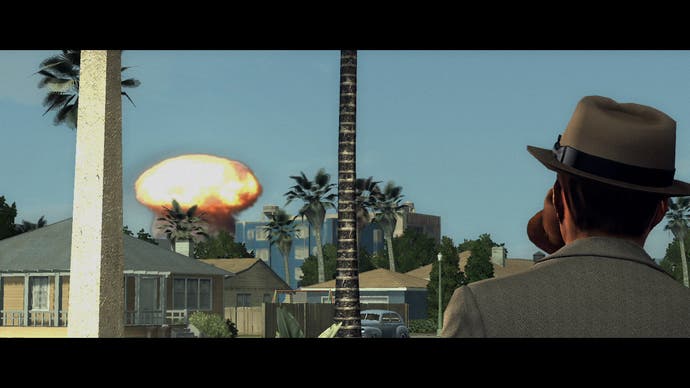L.A. Noire: Nicholson Electroplating
Boom town.
Nicholson Electroplating is like an extra spleen that's been cloned from the stem cells of L.A. Noire and grafted onto its armpit. Sure, it's a mighty fine spleen and all, but if you're just gonna stick it on there, don't be surprised when it fails to come alive.
L.A. Noire is an organism; it can't be broken up into modules. That's what makes L.A. Noire so special, and Nicholson Electroplating so not.
The Nicholson case, a downloadable add-on released this Tuesday, opens with a boom that spreads shrapnel and destruction across a half-dozen city blocks and lofts a mushroom cloud into the air. The epicentre of the blast is the titular metal-treatment plant, which is obliterated.
Playing as Cole Phelps, you and fellow arson detective Herschel Biggs rush to the disaster scene, where you quickly uncover evidence of an experimental aluminium-treatment technique. Because nothing is simple in Phelps' L.A., a miasma of corporate and international intrigue surrounds this lucrative process.
The case inserts itself into the L.A. Noire timeline at an awkward moment. It comes in the middle of the third act, during Phelps' stint as an arson detective. (By the way, I'm going to touch lightly on some plot details of that third act now, so if that offends your sensibilities, skip down a few paragraphs.)
Phelps' arson assignment is when L.A. Noire transforms from "only" an interesting game into an outstanding one. In the manner of all great noir thrillers, the game grabs all its dangling threads and weaves them together.
Those newspaper cut-scenes and war flashbacks; the tantalising near-adequacy of the interview system; the game's insistence on methodical, by-the-numbers police work: they all now sing in harmony.

The game gets bold here. A new protagonist squeezes Phelps out of the picture for a while. It's a courageous creative decision that pays off. Phelps' war "buddy" Jack Kelso finally provides a proper foil to our hero. Kelso gives Phelps some depth and, in a certain light, turns him into something of an anti-hero.
As the facts come together in the Kelso/Phelps arson investigation, it's increasingly hard to tell where the action is going to turn. It's like the approaching resolution of the mystery is closing in on L.A. Noire, and in response the game turns into a cornered cat. It's ready to lash out in any direction. Because L.A. Noire wears so many guises, there are a lot of ways it can go: a shootout, a tense interview, a careful hunt for clues?
L.A. Noire's fragile glories depend on the confluence of a huge number of threads. Nicholson Electroplating doesn't have confluence. In a game where context is everything, this case sits alone.
There is some hand-waving dialogue at the outset of the case that nods toward the main story. Phelps and partner Biggs vamp for the cameras a bit. Gee, we really should be working on that time-sensitive, life-or-death case, shouldn't we? Then there's a big explosion. It's the developers' way of saying, "And now: This."

Because it can't fit into the flow of L.A. Noire proper, this fragment, Nicholson Electroplating, has to find other ways to justify its existence. Fatally, it chooses to take each of L.A. Noire's individual "features" and amp them up a little.
No game can be evaluated merely as the sum of its parts, but L.A. Noire is especially resistant to compartmentalisation. Much like Heavy Rain before it (and maybe more so), if you break this game down into a list of features, the whole thing dissolves into farce.
Taken alone, the gunplay is generic. The driving is sort of clumsy. Searching for clues is a glorified point-and-click exercise.
Rockstar played up its facial-scanning technology in advance of the game's release. We were supposed to drool: Ooh, the faces, the faces, look at these faces! How did we ever play games without all these FACES?

